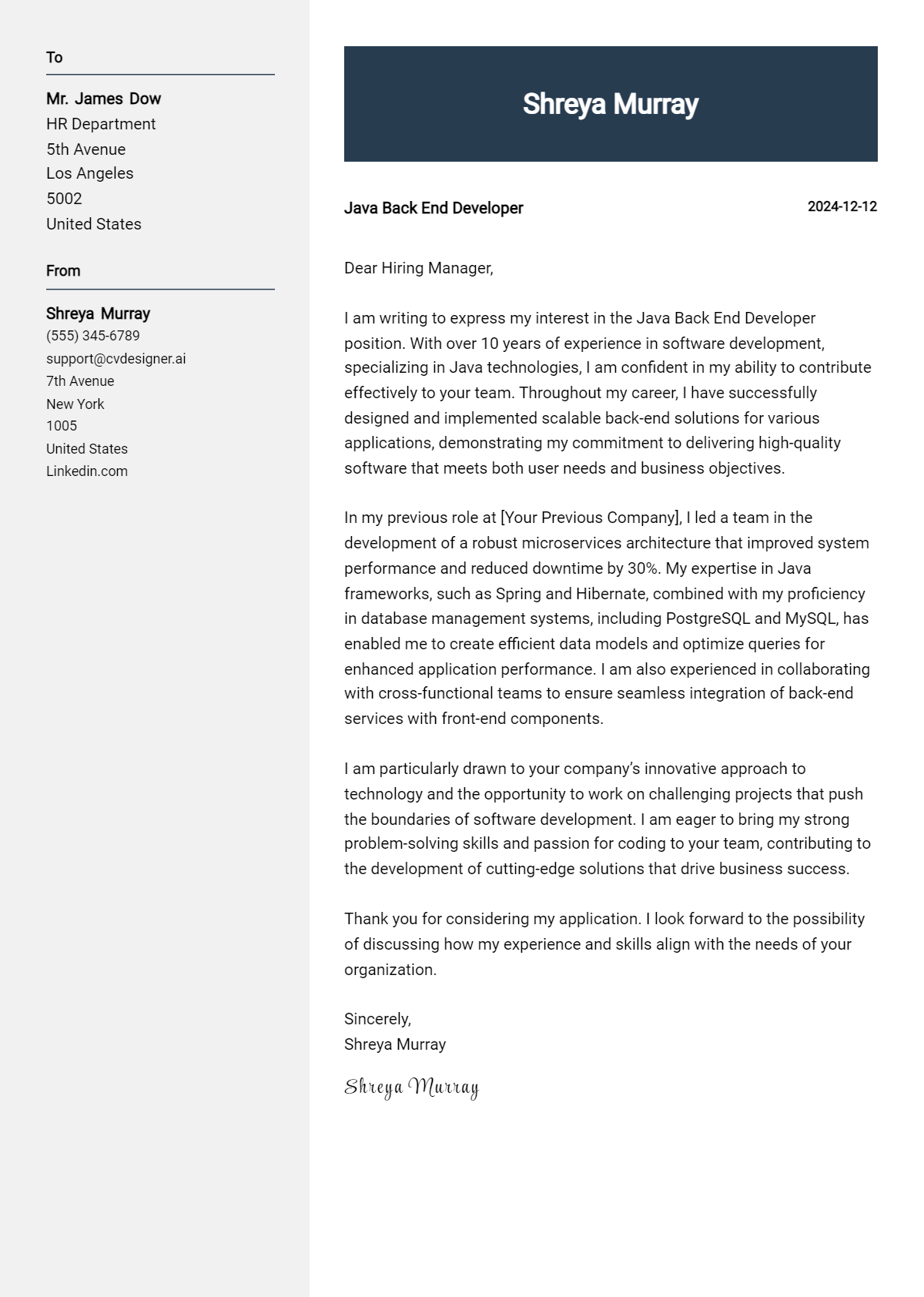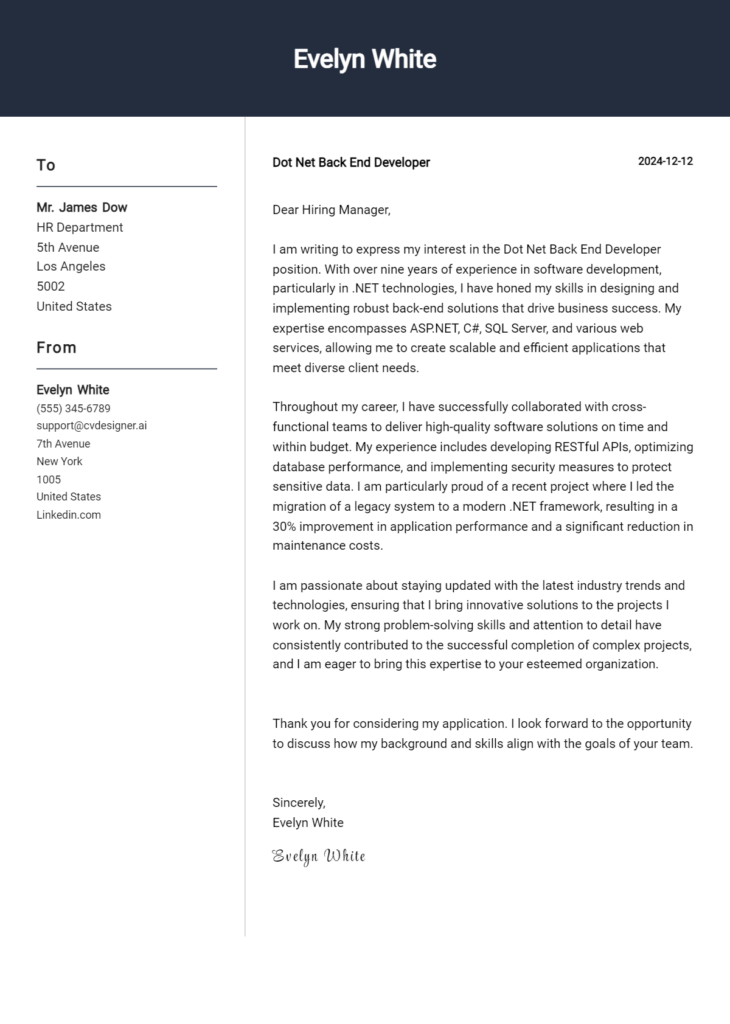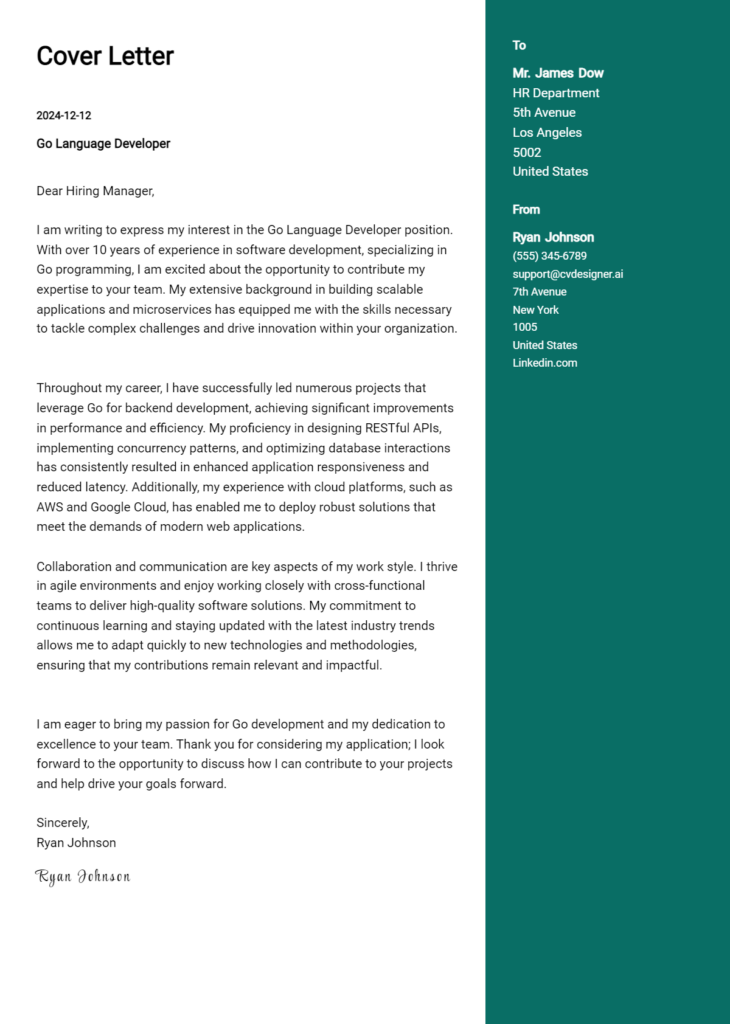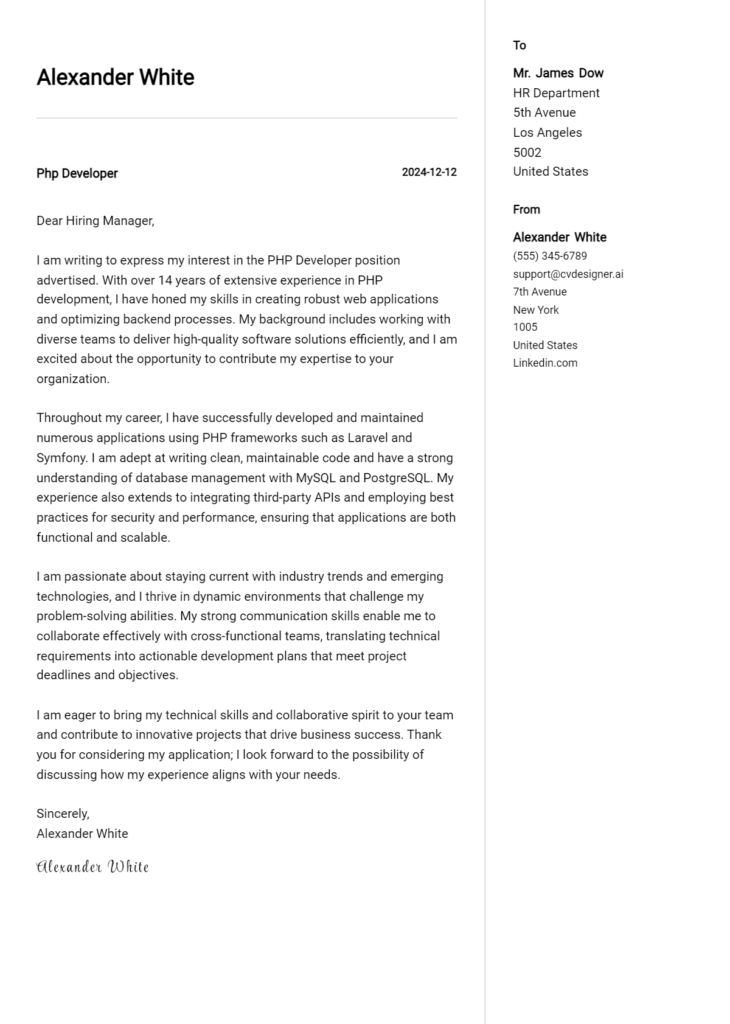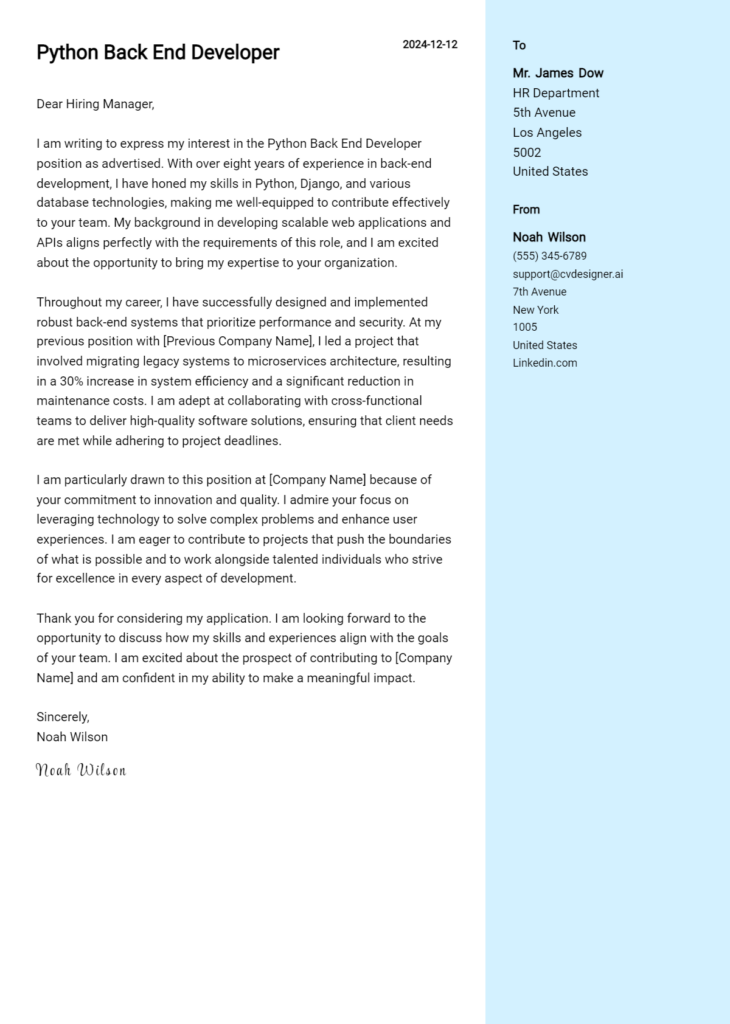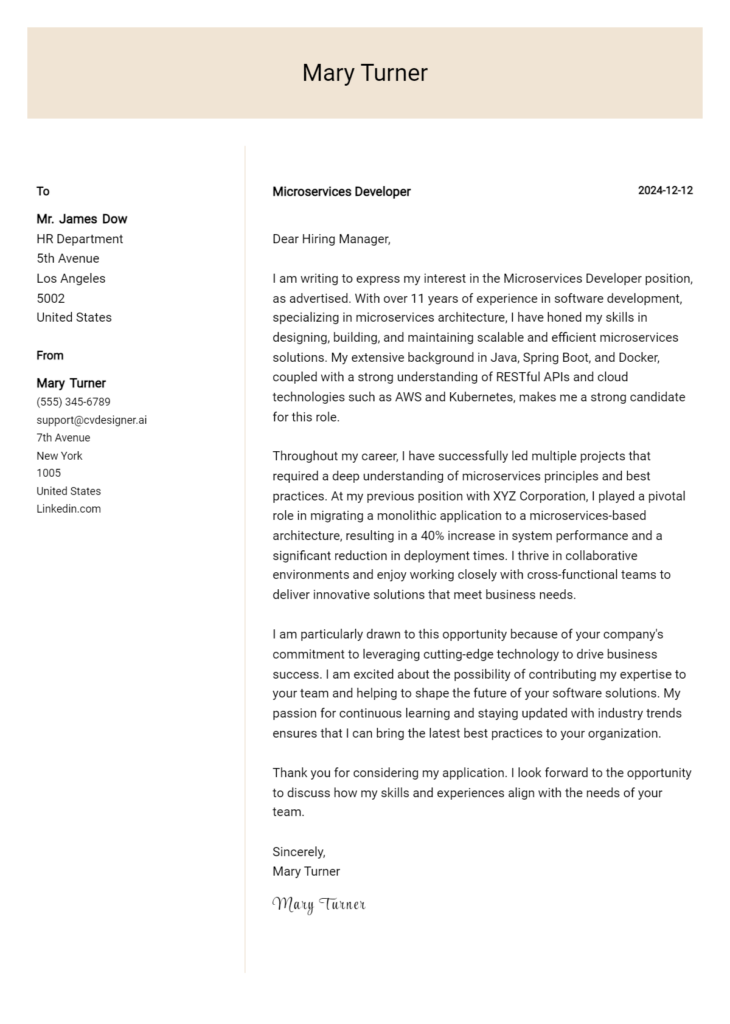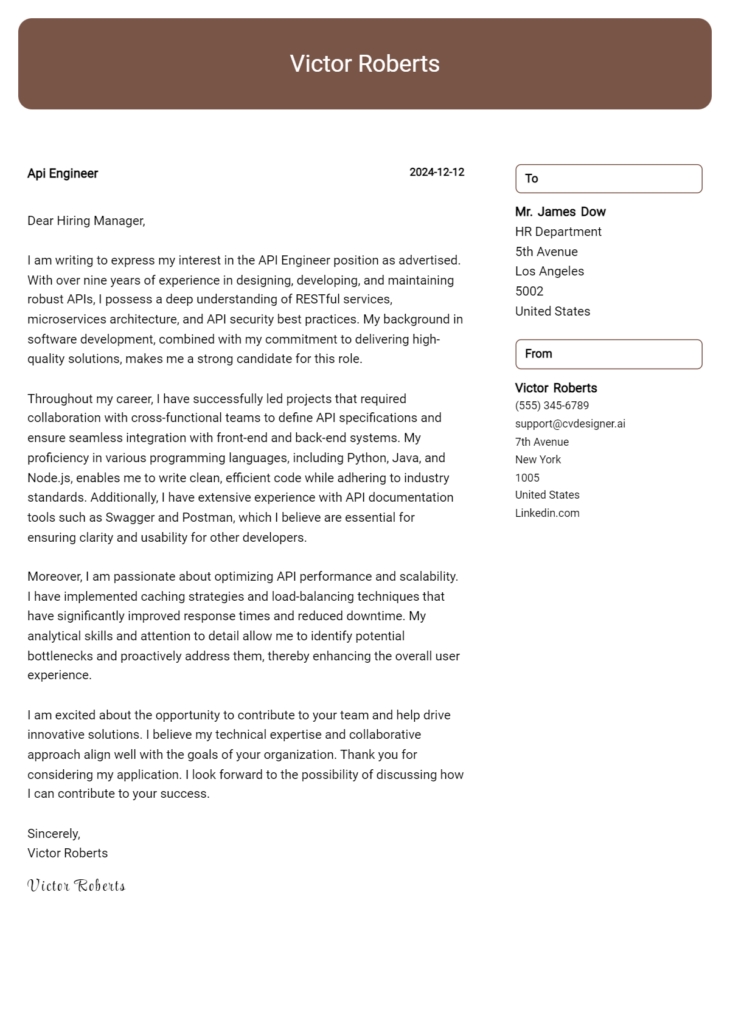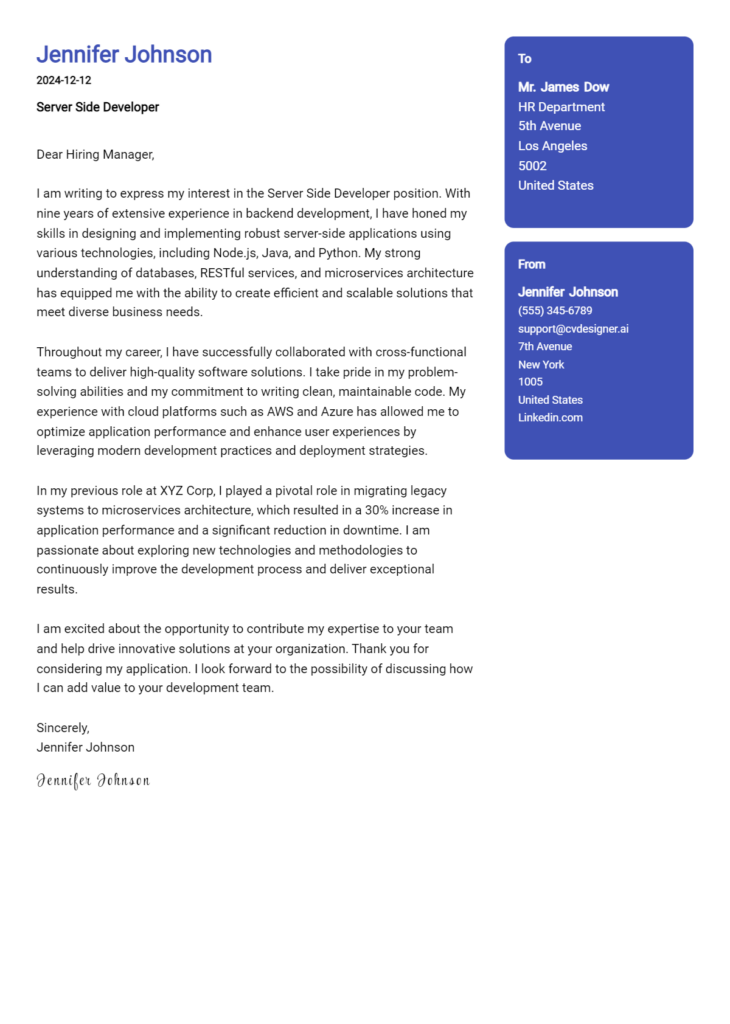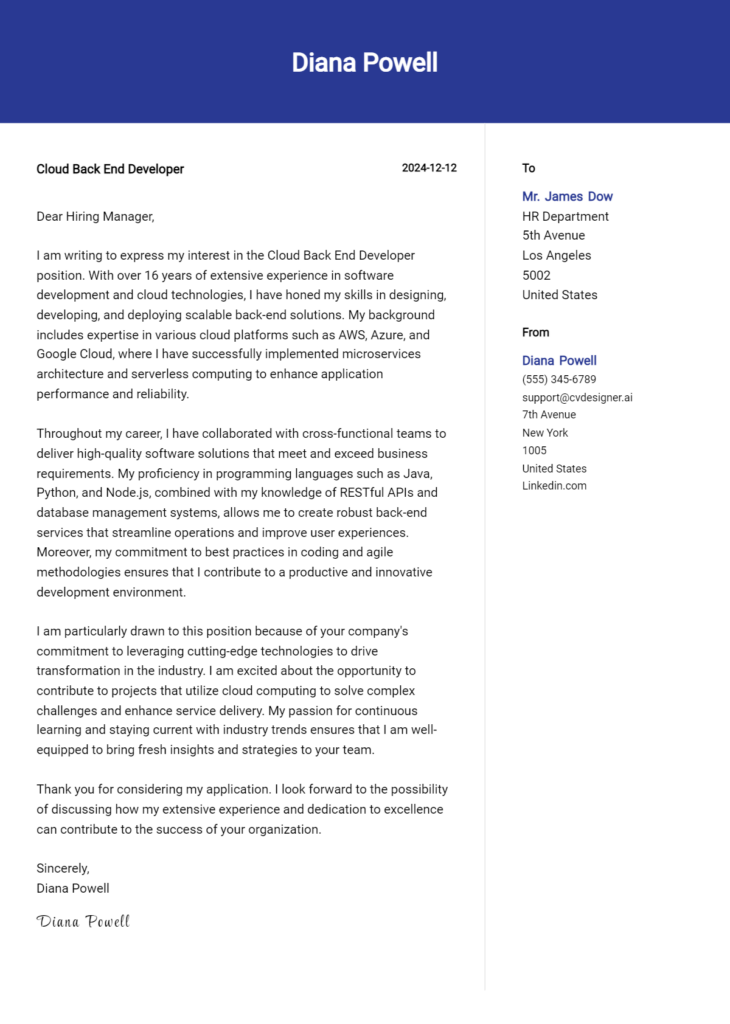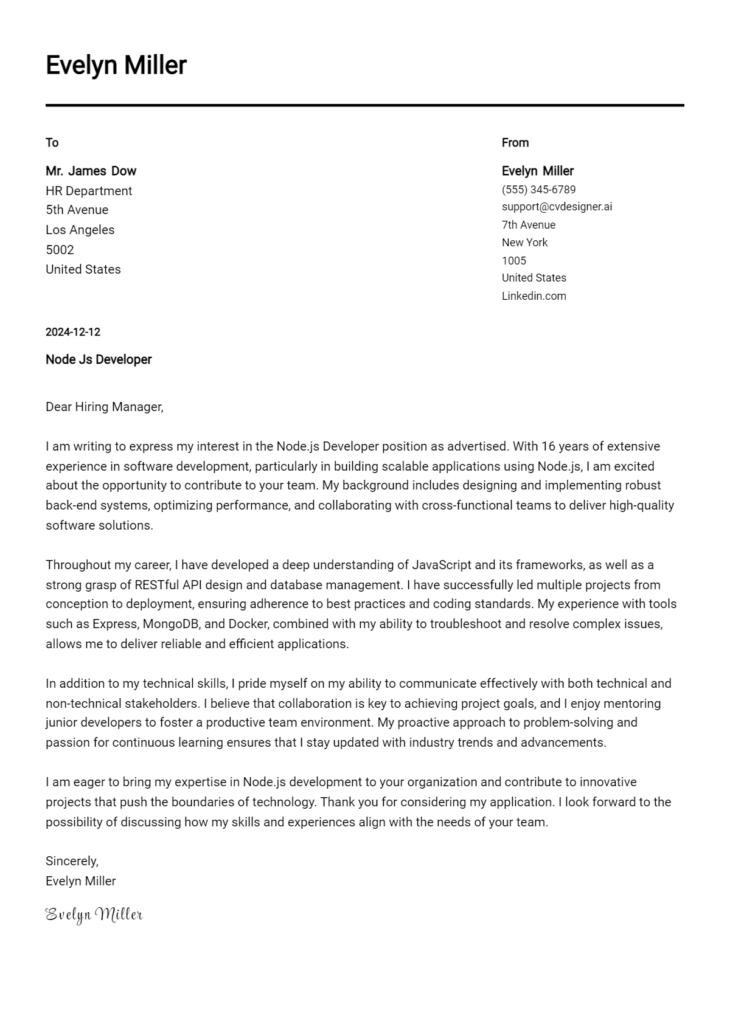Java Back End Developer Cover Letter Examples
Explore additional Java Back End Developer cover letter samples and guides and see what works for your level of experience or role.
How to Format a Java Back-End Developer Cover Letter?
Crafting a compelling cover letter for a Java Back-End Developer role is essential for making a strong first impression. Your cover letter serves as a gateway to showcase your technical skills, problem-solving abilities, and experience with back-end technologies. The way you format this document not only reflects your professionalism but also demonstrates your understanding of best practices in coding and software development.
In this guide, we will outline how to structure your cover letter effectively, ensuring it aligns with the expectations of tech recruiters. Each section of your cover letter is crucial in presenting your qualifications and enthusiasm for the role.
We will focus on the essential components of a professional cover letter, including:
- Cover Letter Header
- Cover Letter Greeting
- Cover Letter Introduction
- Cover Letter Body
- Cover Letter Closing
By understanding and implementing these guidelines, you can create a standout cover letter that highlights your strengths as a Java Back-End Developer. Let’s delve into each part and learn how to make your application shine.
Importance of the Cover Letter Header for a Java Back-End Developer
The header of a cover letter is a critical component that sets the tone for your application. It provides essential information that helps the hiring manager identify who you are and how to reach you. A well-structured header enhances clarity and demonstrates professionalism, which are crucial qualities in the tech industry, especially for a role like a Java Back-End Developer. A strong header typically includes your contact information, the date of submission, and the recipient's details, ensuring that your letter is easily identifiable and organized.
A strong cover letter header not only makes a positive first impression but also reflects your attention to detail—an important trait for any developer. Conversely, a weak header can lead to confusion and may give the impression of carelessness, potentially costing you the opportunity.
Strong Example
John Doe 1234 Elm Street City, State, Zip johndoe@example.com (123) 456-7890 October 10, 2023 Jane Smith Hiring Manager Tech Solutions Inc. 5678 Maple Avenue City, State, Zip
Weak Example
johndoe@Email.com 10/10/23 Hi there,
Importance of the Cover Letter Greeting
The greeting of your cover letter is crucial as it sets the tone for the entire document. An effective greeting not only establishes a level of professionalism but also adds a personal touch by directly addressing the hiring manager. This shows that you have taken the time to learn about the company and the people within it, which can make you stand out among other candidates. To avoid generic greetings like "To Whom It May Concern," it's beneficial to research the recipient's name, which can often be found on the company's website or through professional networking platforms. A personalized greeting can create a positive first impression that encourages the reader to engage with the rest of your letter.
Strong Greeting Example
Dear [Hiring Manager's Name],
Weak Greeting Example
To Whom It May Concern,
The Importance of a Compelling Cover Letter Introduction for a Java Back-End Developer
A well-crafted cover letter introduction is crucial for a Java Back-End Developer, as it serves as the first impression a candidate makes on a hiring manager. This section should not only capture the reader's attention but also clearly express the candidate's enthusiasm for the role. Additionally, the introduction should briefly highlight key skills or achievements relevant to back-end development, such as experience with Java frameworks, database management, or successful project deliveries. A strong introduction sets the tone for the rest of the cover letter and can significantly increase the chances of moving forward in the hiring process.
Strong Example
Dear [Hiring Manager's Name], As a passionate Java Back-End Developer with over five years of experience in designing and implementing robust applications, I am excited to apply for the [Job Title] position at [Company Name]. My proficiency in Java frameworks such as Spring and Hibernate, combined with my track record of optimizing database performance, has enabled me to contribute significantly to previous projects, including a recent e-commerce platform that improved transaction efficiency by 30%. I am eager to bring my technical skills and innovative mindset to your team.
Weak Example
Hello, I am interested in the Java Back-End Developer job you posted. I have some experience with Java and think I could do okay in this role. I hope to learn more about back-end development and contribute to your company somehow.
Purpose of the Cover Letter Body for a Java Back-End Developer
The cover letter body for a Java Back-End Developer serves as a critical component in showcasing the candidate's technical prowess, relevant experiences, and the unique value they bring to the company. This section allows the candidate to highlight specific projects or accomplishments that demonstrate their proficiency in Java and back-end development. A well-crafted cover letter body not only emphasizes the candidate's skills in technologies and frameworks, such as Spring or Hibernate, but also illustrates their ability to solve complex problems and contribute to the team's overall success. By providing concrete examples of successful projects or challenges overcome, candidates can effectively convey their fit for the role and their potential impact on the organization.
Strong Example
Dear Hiring Manager, I am excited to apply for the Java Back-End Developer position at [Company Name]. In my previous role at [Previous Company], I led a team in developing a microservices architecture that improved system scalability by 40%. One of my key projects involved creating a RESTful API for an e-commerce platform, which enhanced user experience and increased transaction speed by 30%. I utilized Spring Boot for the backend, ensuring robust performance and maintainability. My strong analytical skills and attention to detail allowed me to identify and fix performance bottlenecks effectively. I am eager to bring my expertise in Java development and my passion for innovative solutions to [Company Name].
Weak Example
Dear Hiring Manager, I want to apply for the Java Back-End Developer job at your company. I have worked with Java before and know a bit about programming. In my last job, I did some coding, which was okay. I think I can help your team because I am a fast learner and willing to work hard. I hope to contribute to your projects.
Importance of the Cover Letter Closing for a Java Back-End Developer
The closing paragraph of a cover letter is crucial as it leaves a lasting impression on the hiring manager. For a Java Back-End Developer, it should succinctly summarize your qualifications, reiterate your enthusiasm for the position, and encourage the next steps, such as reviewing your resume or scheduling an interview. A strong closing demonstrates confidence and professionalism, while a weak one may come off as uncertain or disinterested.
Strong Example
Thank you for considering my application for the Java Back-End Developer position at [Company Name]. With my extensive experience in Java development and my passion for building scalable applications, I am excited about the opportunity to contribute to your team. I look forward to the possibility of discussing my application in more detail and am eager to bring my skills to [Company Name]. Please feel free to contact me to schedule an interview at your convenience.
Weak Example
I hope you look at my resume and think about me for the Java Back-End Developer job. I guess I would be fine working there. Let me know if you want to talk.
These tips will assist candidates in crafting an effective cover letter for a Java Back-End Developer position. A well-written cover letter is essential for highlighting your technical skills, problem-solving abilities, knowledge of the Software Development Life Cycle (SDLC), teamwork capabilities, and a passion for continuous learning. By effectively showcasing these attributes, you can make a strong impression on potential employers and increase your chances of landing an interview.
Tips for Crafting an Effective Cover Letter
Showcase Your Technical Skills
Start your cover letter by clearly stating your proficiency in Java and other relevant technologies such as Spring, Hibernate, or RESTful APIs. Provide specific examples of projects where you applied these skills. This demonstrates not only your technical competence but also your ability to contribute to the team's success.Highlight Problem-Solving Abilities
Employers value candidates who can tackle challenges effectively. Share a specific instance where you faced a technical problem and how you resolved it. This could involve debugging a complex issue or optimizing a piece of code. Illustrating your analytical skills will set you apart from other applicants.Demonstrate Knowledge of SDLC
Discuss your understanding and experience with the Software Development Life Cycle. Mention any methodologies you've worked with, such as Agile or Waterfall. This signals to employers that you are familiar with industry standards and practices, which is crucial for collaboration within development teams.Emphasize Teamwork and Collaboration
Back-End Development is often a team effort. Mention experiences where you contributed to a team project, highlighting your collaboration skills. This could be through code reviews, pair programming, or participating in team meetings. Show that you can work well with others to achieve common goals.Express a Passion for Continuous Learning
The tech industry is always evolving, and employers appreciate candidates who are committed to self-improvement. Talk about any recent courses, certifications, or personal projects that demonstrate your dedication to staying current with new technologies and best practices. This not only showcases your initiative but also your enthusiasm for the field.
For additional support, consider using cover letter templates or a cover letter builder to help structure your content effectively. Crafting a compelling cover letter can make a significant difference in your job application journey!
Common Mistakes to Avoid in a Java Back-End Developer Cover Letter
Avoiding common mistakes in your cover letter is crucial for making a strong impression on potential employers. A well-crafted cover letter can set you apart from other candidates and showcase your qualifications effectively. Here are some frequent pitfalls to steer clear of when applying for a Java Back-End Developer position:
Generic Greetings: Using "To Whom It May Concern" can make your letter feel impersonal. Instead, try to find the hiring manager's name through research or networking.
Lack of Customization: Failing to tailor your cover letter to the specific job can be detrimental. Make sure to highlight relevant skills and experiences that align with the job description.
Being Too Wordy: Cover letters should be concise. Avoid lengthy paragraphs and unnecessary jargon. Instead, focus on clear, impactful sentences that demonstrate your expertise.
Omitting Technical Skills: As a Java Back-End Developer, it's essential to showcase your technical skills. List relevant programming languages, frameworks, and tools you are proficient in.
Neglecting Achievements: Don’t just describe your duties—highlight your accomplishments. Use quantifiable results to demonstrate how you added value in previous roles.
Poor Formatting: A cluttered or unprofessional layout can distract from your content. Follow a clean cover letter format to ensure readability.
Spelling and Grammar Errors: Typos can undermine your professionalism. Always proofread your cover letter multiple times and consider using tools like Grammarly for additional checks.
For inspiration, you can refer to various cover letter examples to see how to effectively convey your qualifications and avoid these common mistakes.
Cover Letter FAQs for Java Back-End Developer
What should I include in my cover letter as a Java Back-End Developer?
In your cover letter, focus on highlighting your relevant experience and skills related to Java and back-end development. Start with a brief introduction, stating your interest in the position. Discuss your proficiency in Java frameworks such as Spring or Hibernate, and any experience with RESTful services and API development. Mention your familiarity with database technologies like SQL or NoSQL, and any tools you use for version control, like Git. Don't forget to include specific projects or accomplishments that demonstrate your problem-solving abilities and teamwork. Finally, express your enthusiasm for the role and the company, showing how your goals align with their mission.
How can I make my cover letter stand out for a Java Back-End Developer position?
To make your cover letter stand out, personalize it for each application by addressing the hiring manager by name and referencing specific elements of the job description. Use quantifiable achievements to back up your skills; for example, mention how you improved application performance by a certain percentage or successfully led a project that enhanced user experience. Incorporate keywords from the job posting to demonstrate your alignment with the role. Additionally, showcasing your passion for back-end technologies, continuous learning, or contributions to open-source projects can make a strong impression. Finally, a well-structured and error-free letter reflects professionalism and attention to detail.
Should I include technical skills in my cover letter?
Yes, including technical skills in your cover letter is crucial for a Java Back-End Developer position. Highlight your proficiency in Java and any frameworks you have experience with, such as Spring Boot or JPA. Mention your skills in database management, including SQL, NoSQL, or ORM technologies. It's also beneficial to discuss your understanding of microservices architecture, cloud platforms, and version control systems. While it's essential to list these skills, it's even more impactful to illustrate how you've applied them in real-world projects. Providing examples of your contributions to team efforts or successful implementations will reinforce your technical capabilities and show your potential value to the employer.
How long should my cover letter be for a Java Back-End Developer application?
Your cover letter should ideally be one page long, typically between 250 to 400 words. This length allows you to convey your qualifications without overwhelming the reader. Start with a strong opening paragraph that grabs attention, followed by two to three paragraphs detailing your relevant experience, skills, and accomplishments. Use concise language and avoid unnecessary jargon, focusing on clarity and impact. Each paragraph should logically flow into the next, maintaining a cohesive narrative. Conclude with a powerful closing statement that reiterates your enthusiasm for the position and invites further discussion. Remember that hiring managers often review many applications, so being succinct and direct increases your chances of standing out.
Build your Cover Letter in minutes
Use an AI-powered cover letter builder and have your letter done in 5 minutes. Just select your template and our software will guide you through the process.

